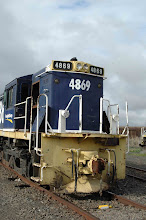I've been able to get quite a bit of modelling done recently. It's good to keep moving as it helps keep the motivation level at it's peak. It's reducing the amount of half started projects, the down side is you start more.....a vicious cycle. If you are a watcher of eBay you will see that I have been selling a few things, that's to keep the funds coming in so I can continue to model. You will also note that my posts are not as regular as some others, that's because when I sit down to post, I figure if there is time to post, there is time to model. So I guess it's about time to put up a new post on a snippet of what has been completed between my PC build and now.
 I have been going through my collection of AMRM's to scan all of the articles of interest and keep them as a data base on my computer for easy reference. I came across a series of articles on the MLE and it derivatives. This is one such, NHFH slab steel wagon. The VR bought some MLE's from the SRA and converted them for steel traffic, I've never been a fan of the MLE until now. For more info read the article and see the conversion process.
I have been going through my collection of AMRM's to scan all of the articles of interest and keep them as a data base on my computer for easy reference. I came across a series of articles on the MLE and it derivatives. This is one such, NHFH slab steel wagon. The VR bought some MLE's from the SRA and converted them for steel traffic, I've never been a fan of the MLE until now. For more info read the article and see the conversion process.  Opposite side of the same wagon. I am very pleased with the out come of this project, so I will go on and build several more for my VR fleet of steel wagons.
Opposite side of the same wagon. I am very pleased with the out come of this project, so I will go on and build several more for my VR fleet of steel wagons. The underframe of the same wagon. Quite a lot of extra styrene is added to build this wagon.
The underframe of the same wagon. Quite a lot of extra styrene is added to build this wagon.
Another derivative of the MLE is the NCMF coil steel wagon for the SRA. Again refer to article of the info, but another good use for a MLE if you are a fan of interstate steel traffic.

Opposite side of the same wagon.

Top view showing the tie down chains.

In my hunt for new ideas I found a picture of L803. A LLV converted to departmental use for electricians. I used a AR Kits GLV that was laying around made a few mods to it and here is the end result. I know the ends aren't correct but I'm not that anal in getting things perfect. Sometimes near enough is good enough.

Note the white box on the end, I presume it is for a power connection similar to a caravan inlet or outlet not sure which.



















































































.jpg)









